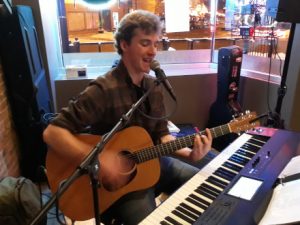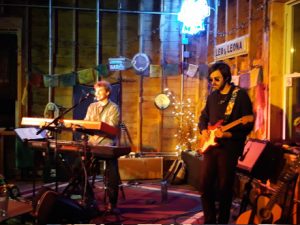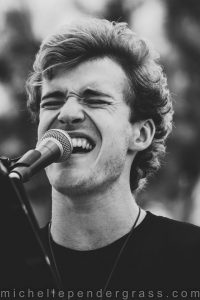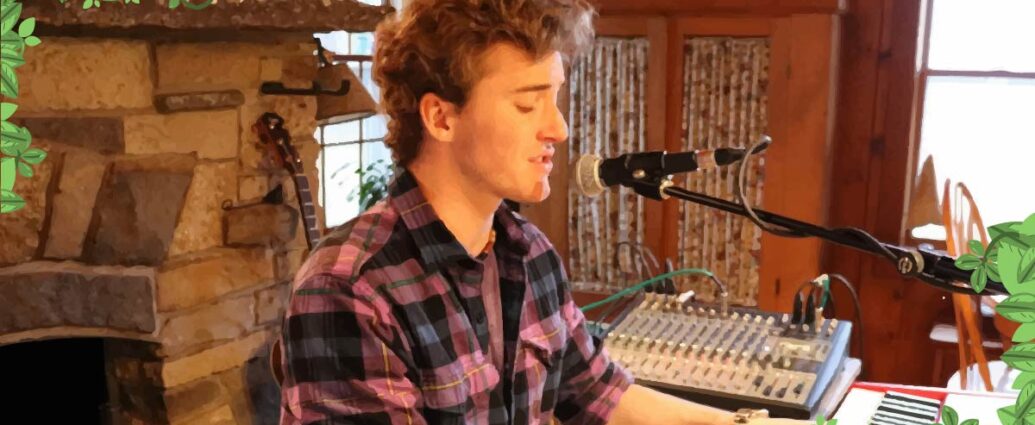By Jonathan Howe –
For some, the Driftless is a place. For others, it is an idea. For local musician, Ryan Howe, it has always been something a bit more meaningful: home. He has lived his entire life atop the bluffs looking over Lake Onalaska, raised under the shade of towering, verdant oaks, and molded by the cream-colored limestone cliffs that border the mighty Mississippi. These are the images one might conjure up, when imagining an interview delving into a musician who has been inspired by the wondrous, natural world around him.
Instead, both the subject and interviewer are planted in office chairs, in front of grainy webcams, trapped inside on a beautifully sunlit day. In parallel universe, one in which there is no pandemic, we might be conducting this interview in the backyard of his residence in Onalaska, or perhaps outside one of the many bars that populate the bustling Coulee Region, or maybe even atop the bluffs at his childhood home in La Crescent. Instead, we are sitting in front of our respective screens and peering at each across a distance of over 150 miles.
 After exchanging pleasantries, and hitting record, we can finally begin to start digging into a story that has been unfurling for 26 years: A native son who has come to roost in the burgeoning music scene that has taken root in downtown La Crosse. To set the table, I decide to keep it simple…
After exchanging pleasantries, and hitting record, we can finally begin to start digging into a story that has been unfurling for 26 years: A native son who has come to roost in the burgeoning music scene that has taken root in downtown La Crosse. To set the table, I decide to keep it simple…
“As a musician, what is it that you do?” I ask.
For Howe, the answer to that question comes in three parts. “Compose, educate, and spiritually elevate.”
Composing music is something that comes naturally for Howe, much in the same way I would sit down at my computer to write an article. “I always knew that writing music was something I wanted to do since I was young,” he says. Whether arranging multi-part choral etudes or improvising over changes on a jazz chart, there’s nothing that captures Ryan Howe’s fascination quite like creating music. However, that isn’t all he does when it comes to putting musical pen to paper.
“Composing, for me doesn’t just mean writing original songs,” he explains. Howe is constantly working to add his own signature sound to the songs and covers he plays live. “When I play covers, I try to add to the arrangements of the songs, further embellishing the structures and adding more texture,” he says. “If I were producing this [live] music for an album, how would I try to make it reach its full potential in a given moment?”
Howe tells me about the changes he makes to the cover songs he performs, “so that people can still recognize the song that’s being played, but in a different manner, with some different musical aspects to kind of alter and add to the depth of what’s being played.” He gives hits such as Stevie Wonder’s Superstition and Elton John’s Take Me to the Pilot a flavor of his own musical originality, one that his audiences have come to expect and appreciate.
Howe performs regularly in the greater La Crosse area, Winona, Rochester, Prairie du Chien, and on a few occasions, venturing up the Mississippi as far as the Twin Cities. While he continues to work on building his brand as a performer, he also strives to grow as a teacher.
“When I teach people,” Ryan says of his exploits in music education, “I try to figure out, what’s their ‘why’ behind what they’re doing? If you understand your students’ ‘why,’ you can better help them achieve their goals.” This approach served him well during his time as a lesson instructor and accompanist at Viterbo University.
“Sometimes, teachers teach to a group or individual in a homogenized, formal system.” He says with a small shake of his head, “Almost like industrially producing students.” Howe feels that the true potential of a budding musician is best unlocked by a teacher who shapes their methods to the skills and aspirations of their students.
Music is also a spiritual endeavor for Howe, who has spent 12 years and counting as a music minister at the Roncalli Newman Center in La Crosse, along with 4 years at the Cathedral of the Sacred Heart in Winona, MN.
“I believe that, at heart, we are all spiritual beings, and we must get in touch with our higher selves. Whatever that means to each and every individual person, that’s their own prerogative, but for me I look at it as music – you feel something.” It’s easy to see from his expression that, for Howe, music truly is a higher calling. “I just get such a thrill off of that. It warms my spirit when people get locked in, spiritually elevating through music.”
I switch tack to something more concrete. “What about this place inspires your art?”
The way Howe speaks of the place of his upbringing is akin to how a lover might daydream about the object of their affections. “This place is so unbelievably beautiful,” he tells me. “What’s so amazing about the Driftless is the age and ancient nature of this landscape.”
Ancient is certainly one way to describe the corridor of land surrounding the Mississippi, stretching from central Minnesota down to upper Illinois. A vast chain of ecosystems that was missed by the transformational touch of multiple ice ages thousands of years ago carries a feeling of both antiquity and timelessness.
Howe’s praise takes on a note of concern. “This area has such immensely beautiful and fascinating history, features and cultures behind it. Growing up here has the potential to really spoil people, because if you never leave this area, you think, ‘Gosh, isn’t the whole world like this?’” He shakes his head before continuing, “And that’s just not the case.”
He talks about the mindfulness he strives to maintain when considering just how special the Driftless Area is. “When I’m thinking about this area, I will always try to appreciate it and never take it for granted.” He then focuses on some aspects of the Driftless Area that make it unlike anywhere else in the world. “The Upper Mississippi Wildlife Refuge is one of the most diverse waterfowl corridors on planet Earth,” He notes, “and the fisheries here are also pretty good. I love going out and fishing.” Indeed, The region is known the world over for it’s pristine streams that’s home to some of the best trout-fishing out there.
Having said that, Howe acknowledges that appreciation of this special place can’t be all about taking. Conservation efforts run deep in his family, and it’s always been a prevalent part of his life, whether it’s volunteering for controlled burns or removing invasive plant species from local ecosystems. “I draw so much appreciation and joy and fulfillment from trying to be an active steward of nature and keeping that as part of my lifestyle,” he says.
“We share this planet. We’re not the only people or things that live here,” “We should feel obligated to – not just for ourselves but for all life on planet Earth – keep this planet in as good of shape as possible. That is a soap box that I will never come down off of.”
“Was there any music you wrote that you felt was inspired by your life here in the Driftless?”
“The foremost example I’ll mention is A Place to Be.” Howe says with a smile. He tells me about how he and his cousin, Garrett Starke, were experimenting with 12-string guitars in non-standard tunings. “Garrett was showing me some of these late-60s, early-70s kind of Indie singers/songwriters.” Howe explains to me how these artists broke the mold, introducing musical ideas that hadn’t been seen in the mainstream music scene. “Like taking a 12-string and putting it in dropped-D tuning or putting it in a major chord with suspended 4th tuning.” For those not well-versed in music theory these stylistic changes were cast in stark relief next to the wall-of-sound trend of pop music. Howe and his cousin drew inspiration from this phenomenon when writing the beginnings of what would eventually become A Place to Be.
“It’s a call to awareness,” says Howe, speaking of the song. As such, he felt it needed to be upbeat and full of energy. The tuning and key of the song reflect that. “I could talk all day about why I think the key of E major in the brightest, happiest, most sunlit key, and the greenest key,” He says with a chuckle.
Without further ado, we dive into the first verse of the song, breaking the lyrics into couplets.
I danced and ran through the tall grass and flowers
In the daylight, I felt heaven’s rain showers
“That’s just like the sun raining down on you,” Howe comments. Indeed, the opening lines paint a pastoral scene of sun-soaked prairies nestled atop, in between, and beneath the bluffs of the Mississippi River Valley.
I was younger, I saw those loving spirits play
I was younger, living and breathing and dreaming big at the end of the day
 Howe explains, “This harkens back to my younger days where we grew up with nature all around us on our family homestead, up above La Crescent, MN.” He tells me about a hillside near his childhood home that would qualify as any prairie enthusiast’s dream-come-true. “The Bowl,” as he refers to it, is an expansive tract of wildflowers, short and tall grasses, and wildlife habitat that his family still maintains and cares for to this day.
Howe explains, “This harkens back to my younger days where we grew up with nature all around us on our family homestead, up above La Crescent, MN.” He tells me about a hillside near his childhood home that would qualify as any prairie enthusiast’s dream-come-true. “The Bowl,” as he refers to it, is an expansive tract of wildflowers, short and tall grasses, and wildlife habitat that his family still maintains and cares for to this day.
“As the seasons would change, you’d go through different bunches of wildflowers coming up; the milkweed and pale purple coneflowers in June and early July; then you’d have Brown-Eyed Susans and Yarrow and Rattlesnake Master in the midsummer; and in the beginning of September, you‘d have all the sky-blue and purple Asters, all the species of Goldenrod coming out.” He said, describing the vivid parade of floral residents of the prairie he’d grown up on. He finishes breathlessly, “It’s just a non-stop color rush.”
The second verse of the song jumps forward in time, from recollections of idyllic childhood memories to a current, more serious reality.
I missed those thoughts and that carefree old feelin’
It seems I’m stuck, and at times I’m reelin’
Howe speaks of a natural loss of innocence that came over him as he transitioned from his carefree youth to the rush of adulthood and integrating into society. “[I missed] just the being able to be present, and not having to worry about all these external distractions and voices and thoughts.”
The changes of growing up did not always come easily for Howe. “I do struggle with Generalized Anxiety Disorder,” he tells me in a moment of vulnerability, “and I have struggled with depression at times.” Howe’s candor regarding his personal wellbeing is not wasted on me, and it comes as little surprise, when one considers the growing percentage of young adults being diagnosed with depression and anxiety, which has been accompanied by a rise in mental health awareness.
We move to the next lines:
Now I’m older and I feel a change of pace
Now we’re older and we’ve got to make the world a place, Where all can be
“The world is moving faster, life’s moving along much faster,” Howe narrates, breaking down the passage. He notes that sometimes, when performing the song live, he changes the end of the second verse to “Where all can breathe,” a respectful nod to the recent groundswell of vocal support for racial equity and the systemic violence that movements, such as Black Live Matter, seek to end.
“I believe we all deserve, as people, to feel safe, have what we need to survive – clean water and plenty of good, nutritious food – a place to roam and run around, to be ourselves, and not be judged.” He adds with firmness, “[not] by the color of our skin, our gender, our ethnicity, what we believe in… we all need a place where we can just be.”
After pausing a moment to let the words sink in, Howe presses on, directing my attention to the song’s bridge.
Forget the sand
Forget the oil
And ride the with sun, water, and air
Howe is not shy when he explains the meaning behind these lyrics. “Kind of self-explanatory,” he says plainly. “We need renewable energy in this country. I cannot say that enough.” The struggle between an aging fossil-fuel industry and upcoming sustainable energy is a sentiment that hits close to home for many in the Driftless Area. Residents of Winona County are already aware of the threat posed by frac sand mining exploits that have loomed over the region in the last decade. This song takes those controversial land practices head on.
Forget the money
Forget the power
Our Mother Earth needs tender love and care
The second half of the bridge represents a call to action. “There has been a great neglect for environmental sustainability in how this country consumes and produces energy and food,” Howe points out. “It falls on the generations [living] right now to really adapt and change the way we live, to be sustainable not just for ourselves, but those who come after us.” While the impact individuals can have may seem small, he believes it’s something we should always be mindful of. “That’s just being aware, conscious, and good human beings.”
I know around me, guardian angels fly
Mem’ries stay true and stoke a fire the never dies
This passage tells of Howe’s family and friends who have instilled in him a deep love for the place he grew up in. “Those [things] never go away,” says Howe, ardently. “If you can hold onto something like that, you’re very blessed and fortunate, and that’s exactly how I count myself.”
Always, always remember to plant your roots
Find the high, firm ground, and in the golden sun unleash your bright, green chutes
The symbolism in these lines is easy to see. “It’s as if you’re a tree [or a] plant,” says Howe. “Stay out in the sun, stay in nature where we belong as animals.” He explains that he feels that people, himself included, can often get too tied up in the expansive online world we no live in and forget to stay in touch with the world that’s right in front of us. “Marvel movies are awesome,” he concedes, noting a personal vice of his own, “But going for a canoe trip is much more holistic and therapeutic and inherently healthy for a human being.”
He segues into the final stanza, a couplet that summarizes the musical climax and gradual descent that follows.
Now I’m older and I feel a sense of place
Now I’m older and I need to find my space, a place to be
 These final lines contain the boiled-down essence of the song’s meaning: We all grow older and realize the need for belonging, for community. It outlines the ever-present need to create a place where everyone has a right to exist: a place to be.
These final lines contain the boiled-down essence of the song’s meaning: We all grow older and realize the need for belonging, for community. It outlines the ever-present need to create a place where everyone has a right to exist: a place to be.
“So, we’ve talked about what you have done already. What’s next?”
Howe is happy to seize this opportunity to talk about his first studio album, Origin. It’s a compendium of 9 songs that he wrote, recorded, and collaborated on from 2010-2020 at Carpet Booth Studios in Rochester, MN. A Place to Be is among the songs that will be on the album. “There’s a lot of things that can happen in the span of 10 years,” he remarks. “It’s been a labor of love, and a lifelong dream that’s just starting.” Howe plans to release the album during the summer of 2021.
He goes on to reiterate how recording the album and his experience as a musician in the region continues to shape his craft. “Being in a place that’s so beautiful, and such an inherently good place to grow up, it just fostered a ton of curiosity and fascination and wonder.” He believes these attributes will drive him to continue evolving and innovating his sound. “Combining the widespread cultural appreciation of nature’s beauty in the La Crosse area with the artistic talent here in this community… I just became a part of that.”
I prompt him about any future project that he hasn’t already started to work on. He stops to think before answering.
“I think a lot about the health of our water systems, as it pertains to soil erosion, farm pesticide run-off in our water systems,” he says. “There are certain places, in particular Trempealeau County, [where] pesticide run-off is turning parts of the Trempealeau River reddish orange,” says Howe, putting on a pained grimace. He then recites a sort of mantra that he has become fond of: “What we do to the water, we do to ourselves.” This is a theme echoed in the music of fellow artist Sophia Landis, who lives in Prairie du Chien, WI, and has been an active advocate of local conservation through her music.
Howe also draws inspiration from a more hopeful front as well. “I’ve thought of writing [music] about raptors, eagles, and falcons,” he muses. It’s little secret that the return of raptors, such as Bald Eagles, Peregrine Falcons, and American Kestrels, to the upper Midwest has been one of conservation’s greatest success stories.
“Bringing those species back from extirpation […] that’s always been such an inspiring story to me,” says Howe, and he believes future projects may focus on that story.
While Howe’s concern and love for the Driftless Area is certainly a muse for his art, it’s hardly the only source he draws from. He also writes music about his experiences in the La Crosse music scene and his personal life “If you’re an artist, your music should sound like your life, and I’m trying to do that more and more authentically,” Howe states. “I’m really excited to see what pathways that takes me down.”
Count this writer as one who is also excited to see what path Ryan Howe’s career takes, as the home-grown songwriter continues to spread his song, fueled by the land he calls home.

